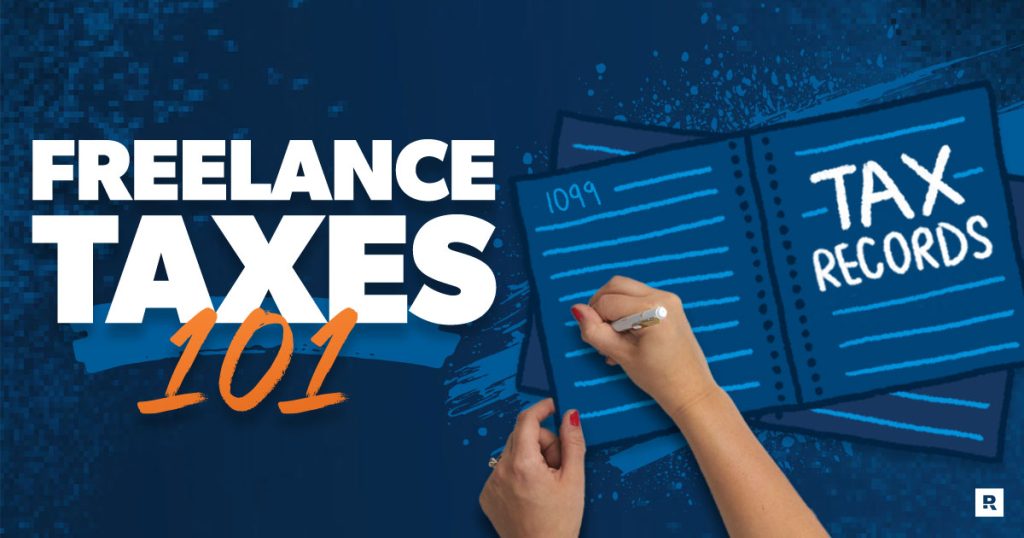Being a freelancer means being your own boss, which can feel pretty stinkin’ awesome. And you’re not alone. In fact, a recent study found that in 2023 about 64 million Americans did some form of freelance work—making up 38% of the labor force and contributing $1.2 trillion to the U.S. economy.4
And freelancing comes with some sweet perks. You get to choose your hours, what projects to take on, and where you work. Basically, you get to be your own CEO! But that’s also where the downside of being your own boss comes in. Yup, we’re talking about taxes.
Whether you’re a full-time freelancer or you just make a few hundred bucks here and there with a small side hustle, it will impact how you file your taxes. And if you’re not careful, you could lose a large chunk of your freelance income to an enormous tax bill. Let’s run through some important basics that freelancers need to know about their taxes.
What Taxes Do I Owe on My Freelance Income?
In most cases, freelancers are on the hook for two types of taxes: income taxes and the self-employment tax. Here’s how it shakes down—if you earn $400 or more from freelance work in any given year, you’re responsible for paying the self-employment tax on those earnings.5
But keep this in mind: You need to report all income on your tax return—yes, even freelance income under $400. Why? Because even if you’re not getting hit with the self-employment tax, that money is still taxed as part of your income.
How Much Should I Set Aside for Freelance Taxes?
We recommend setting aside about 25–30% of your freelance income in a separate savings account to cover both income taxes and self-employment tax. Your future self will thank you.
No, really, you don’t want to get blindsided by a huge tax bill once tax season rolls around. Searching between the sofa cushions for cash to pay Uncle Sam the night before Tax Day isn’t fun. Trust us on that one.
What Is the Self-Employment Tax?
The self-employment tax is a 15.3% tax on your freelance income, and it solely exists to cover your Social Security and Medicare taxes.6
At a normal full-time job, your Social Security and Medicare taxes are taken out of your paychecks automatically—and your employer covers half of those taxes. But as a freelancer, you’re considered both an employee and an employer. That’s why the IRS wants you to cover the whole 15.3%.
The Schedule SE tax form helps you calculate your self-employment tax, which you’ll then report on your standard Form 1040.7 And remember, the self-employment tax is in addition to your regular income taxes.
Got small business tax questions? RamseyTrusted tax pros are an extension of your business.
Okay, that might sound like a lot to shell out, but don’t freak out just yet. The IRS actually lets you deduct half the self-employment tax (the half your employer would’ve paid) from your income on Form 1040.8 So while you still should make the quarterly payments in full (more on that in a minute), you’ll at least get some relief when it comes to your income taxes.
How Do I Find Out if I Need to Pay Quarterly Taxes?
That’s a great question! According to the IRS, you should pay estimated taxes quarterly if you expect to owe at least $1,000 in taxes on the income you make from freelance work this year.9
Why Do I Need to Pay Quarterly Taxes?
The U.S. is a pay-as-you-go tax system. If you have a normal 9-to-5 job with a salary, benefits and the whole nine yards, chances are your employer is withholding taxes from each paycheck and sending that money to Uncle Sam to cover your tax liability throughout the year. But that’s usually not the case with your freelance income—and that’s where quarterly taxes come in.
If you’re only making a couple thousand dollars or less freelancing each year, you can probably skip quarterly tax payments and just report your freelance income when you file your tax return. But if you expect to owe $1,000 or more in taxes on your freelance income for the year, Form 1040-ES can help you estimate your income and ballpark your projected taxes.10
When Do I Have to Pay Quarterly Taxes on My Freelance Income?
Like we said earlier, the federal government is impatient and doesn’t want to wait until next April to collect your tax dollars. So if your freelance gigs are booming, you’ll probably need to pay the IRS on a quarterly basis.
Here are the quarterly estimated tax deadlines for the 2025 tax year:11
|
When You Get Paid |
Tax Due Date |
|
Jan. 1–March 31 |
April 15, 2025 |
|
April 1–May 31 |
June 16, 2025 |
|
June 1–Aug. 31 |
Sept. 15, 2025 |
|
Sept. 1–Dec. 31 |
Jan. 15, 2026 |
If you underpay your quarterly tax payments—these are estimates, after all—you’ll have to pay the remaining taxes when you file your annual tax return. (And yes, freelancers must file an annual tax return by April 15—just like everyone else.) On the other hand, if you overpay your quarterly taxes, you’ll receive the excess amount back in the form of a tax refund.
What Other Tax Forms Do I Need to File My Taxes as a Freelancer?
As you can see, freelancing comes with a little extra paperwork at tax time. In addition to your typical tax forms, there are a few specific ones you might need to gather to report your income and expenses accurately. Here’s a quick rundown:
1099-NEC
As a freelancer, you should receive 1099-NEC forms (which stands for nonemployee compensation) from each business client who paid you $600 or more.12 For example, if you’re an event photographer who worked several corporate events for a specific company in your town, you can probably expect them to send you a 1099-NEC form.
1099-K
What if your customers or clients use Venmo, PayPal or other online payment systems to pay for a product or service you offer? If that’s the case, you might get 1099-K forms from those online payment systems instead.13
Schedule C
If you don’t receive a 1099-NEC or 1099-K from a client, that doesn’t mean you’re off the hook. You still need to report all self-employment income to the IRS using a Schedule C form.
A Schedule C tax form serves as the hub for all your freelance income and expenses. First, you’ll report all the freelance income you earned during the tax year in Part I. This includes amounts already reported on the 1099 forms you received from clients and amounts not yet reported from clients who didn’t send a 1099. After that, you’ll list your expenses in Parts II–V to see if you can claim any deductions.
Tax Deductions for Freelancers
Tax deductions lower your taxable income, potentially reducing your tax bill and saving you hundreds of dollars in the process. And as a freelancer, you get to claim a bunch of them! But many self-employed professionals don’t take advantage of tax deductions they qualify for. That means some freelancers are paying more taxes than they have to. Yuck!
You already know you can deduct half the self-employment tax on your 1040 at tax time. You can also claim deductions on expenses the IRS considers “ordinary and necessary” for the operation of your business.
Some of the most common deductions for freelancers include:
- Advertising and marketing
- Office supplies
- Computer equipment and software
- Travel and business meals
- Home office
- Utilities
Careful documentation and detailed bookkeeping—like saving all your original receipts and invoices—can help you prove those expenses were vital to your business, which will save you money come tax season.
A simple way of tracking your expenses is by opening a separate checking account specifically for freelance work. It’s a great way to keep your personal and business finances separate—and track your expenses so you can claim them on your income taxes.
How to Pay Your Freelance Taxes
As a freelancer, you need to understand how to file and pay your taxes the right way. It’s not optional—this is part of the job!
The good news is, you don’t have to be worried and stressed every tax season. If you follow these simple steps, you’ll be able to file your taxes with confidence and focus on what you love most about your freelance gig:
Step 1: Keep accurate records of your income and expenses.
Make sure to keep all of your receipts, invoices and financial records organized and up to date. This will make it much easier to prepare your tax return and claim any self-employment deductions you might qualify for.
There are plenty of accounting software options out there that make it easy to track your income and expenses as you go. That way you’re not trying to dig through a mountain of receipts trying to figure out how much you spent on office supplies seven months ago.
Step 2: Determine whether you operated at a profit or loss.
As a freelancer, you’re probably going to be seen as a sole proprietor by the IRS for tax purposes. This means you’ll report your freelance income and expenses on a Schedule C (Form 1040), which is part of your personal tax return (because the business is you—not a separate entity like a corporation or partnership).
This form will show the IRS whether you earned a profit through your freelance work or operated at a loss. Ultimately, you’ll pay taxes on the net profit or loss you report on your Schedule C.
Step 3: Pay estimated taxes quarterly.
Like we mentioned earlier, since you won’t have taxes withheld from your freelance income like you would if you were a salaried employee at a “normal” job, you’ll probably need to pay estimated taxes every quarter.
You can use Form 1040-ES to estimate how much you owe each quarter and send in your payment to the IRS.
Step 4: File your tax return.
We’re in the home stretch now! To file your tax return, you can either file electronically using a reliable tax software—like Ramsey SmartTax—or hire a tax professional to help you with your return. But make sure to file your tax return by Tax Day, which is typically April 15 every year (unless that day lands on a weekend or a holiday).
Just remember that as a freelancer, you’re the boss. That means it’s on you to keep accurate records, pay your taxes quarterly, and file your tax return on time. As long as you follow these steps, you’ll stay on top of your tax obligations and avoid any late penalties and interest charges from the IRS.
Find a Tax Professional You Can Trust
Let’s face it—taxes are complicated. And when you’re self-employed, they can be even trickier to navigate.
One of the biggest mistakes a freelancer can make is trying to roll solo in tax season. So, if thinking about all the 1099s and Schedule Cs raises your blood pressure, it’s time to ask for help.
Read the full article here










